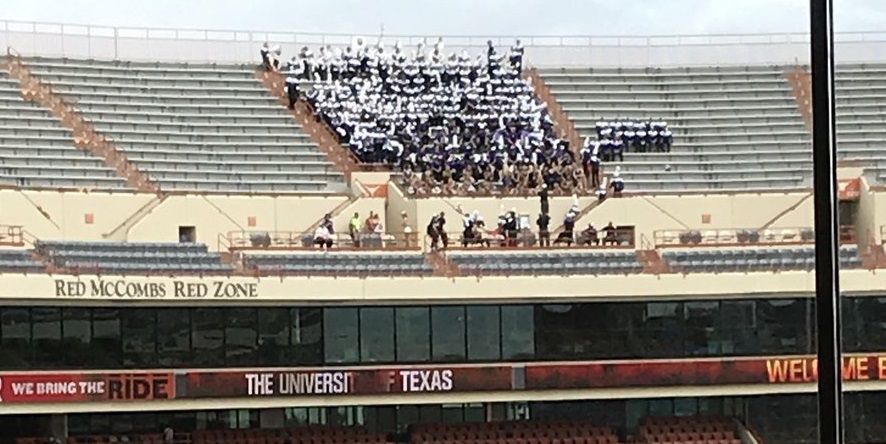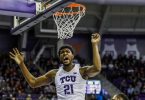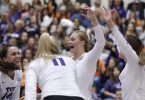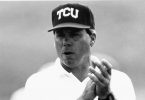It was 6:30 a.m. on a soggy Saturday in Fort Worth.
TCU marching band members arrived in a parking lot adjacent to Amon G. Carter Stadium as they packed for their 190-mile trek to Austin. Nine hours remained before the TCU football team would kick off against Texas.
Why such a head start? Better to be on the scene three hours early than three minutes late, as the band often puts it.
Come the early afternoon, it became quite clear that some margin can never hurt.
By 1:45 p.m., University of Texas students had begun filing into 100,119-seat Darrell K Royal-Texas Memorial Stadium. Most of the grandstands were empty at that point, but the already raucous crowd behind the Horned Frogs’ bench was hard to overlook.
And about 50 yards north and more than 100 feet high of the Longhorns’ student section, there was a patch of purple and white, perched in the northeast corner of the upper deck, likely with a better view of Round Rock than the turf where Texas would soon hand No. 17 TCU a 31-16 loss.
From the field level, it could have been mistaken for a colony of ants. Even from the press box, itself eight floors above the field on the opposite side of DKR, binoculars were needed to see tubas, trombones, drums and perhaps even an oxygen tank or two scattered throughout the isolated group of individuals.
Wait, what was the TCU marching band doing all the way up in the stratosphere?

Dean Straka/Sptspage
Congratulations, you’ve asked the million-dollar question.
Before long, the peculiar sight had made its rounds across social media. Five minutes into the second quarter, the band had vacated its post — simply to make it downstairs in time for its halftime performance. When the Frogs scored their lone touchdown of the day with six seconds to spare in the first half, there was no fight song to jam along to.
And when the band, void of any TV microphones, played the alma mater postgame, there was no salute from TCU players or coaches to the fans who had traveled to the game. Simply put, finding — let alone even hearing — the band amid a celebratory crowd of 95,124 was like a needle in a haystack for Gary Patterson as his team headed towards the locker room.
Even if Tulsa and USC had received the same dose of hospitality from Texas in the two prior games at DKR this season, it didn’t stop the Longhorns from quickly creating a social media firestorm.
“This is my 20th season here and we’ve never been that high in any stadium,” TCU marching band director Brian Youngblood said.
It wasn’t without any warning for Youngblood and assistant marching band director Matt Garrett, who had learned they’d be placed in the nosebleeds months ago when they received ticket information from the Longhorns.
TCU band members, however, weren’t filled in on the news until they were directed to start walking toward the ramps — not the lower bowl — after entering the stadium.
And the shock value was perhaps even greater for veteran band members, whose only previous experience at Texas involved seats with a much closer proximity to the on-field action.
“We got to the stadium and I was thinking we’d be right in the same spot, and I was all excited about it,” senior base drummer Brandon Kitchin said. “Then we went through a different entrance, and I was like, ‘What are we going upstairs for?’ Suddenly we were going up one of those ramps that must have been 14 to 15 loops.”
Collectively, it dawned upon the band members that nothing would come easy for them in this one.
“The [ramps] just seemed never ending,” sophomore band member Kasie Haemker said. “And halfway through getting into the stands, Mr. Youngblood told us that we were also by the spot where they set the fireworks off. Everyone was like ‘great.'”
And as the game progressed, fireworks rocketed above the band far louder and more frequently than any noise the band was able to produce.
True, Youngblood and Garrett at least had some warning that the day would be unlike any other. But one can only do so much in these types of settings in regards to eliminating headaches.
“From a logistical standpoint, it was definitely challenging to manage going up into the seats, back down, back up and so forth,” Garrett said.
Let the time commitment for that otherwise routine task speak for itself.
“It took us, without any fans in the way and just walking straight nonstop, 8.5 minutes to get from ground level to upper level, and then about another seven minutes to get to our seats,” Youngblood said.
That 15-minute migration in both directions wasn’t just a one-time hurdle, either. Counting the descent and ascent for the pregame and halftime performances, it was full-on marathon for the band.
The round-trip for set-up? 30 minutes.
The trip back up to get settled for the first half? Tack on another 15 minutes. Add another 15 to journey to the field for the halftime show. A tight game prevented the concourse from being any more packed than it needed to be at that point. Same story for the trip back up.
Throw on the final 15-minute exodus at the end of the game, and the TCU band spent approximately an hour and a half becoming the new geography experts of Bevo’s castle.
Of course, getting from Point A to Point B wasn’t the only impediment. The climb to the upper-deck location wasn’t exactly designed for students carrying 35 to 40 pounds of drums, tubas and other equipment.
“We had some students who were concerned about the angle of descent because it’s a much sharper angle there [than Fort Worth],” Youngblood said. “The way the bench seats were laid out was semi-unusual.”
Those were far from being the only surprises, considering band had prime seats in previous visits to Austin. Even the customary courtesy curbside drop-off, for all practical purposes, wasn’t in the cards for the band upon arrival this time.
“Not only did we have to sit up high, but last time we got to park about 100 yards from the stadium,” Youngblood said. “This time we had to park about half-a-mile from the stadium.”
Bring out the pedometer, my friends. Kitchin, for one, decided to do just that — hitting 17,000 steps before his phone died with plenty of time left in the game.
“I must have had 20,000 steps that day, probably even more,” Kitchin said. “I got a good workout in.”
Gee — you might as well say 40,000 steps with the bass drum in tow. Give the snare drummers some credit, too, for the similar pains they endured.
“It was a little disorienting but we got pretty used to it,” sophomore snare-drummer Anthony Peterson said. “My feet were definitely starting to hurt by the end of the day, but it’s kind of what we signed up for.”
But back to the heart of the question: Was it truly necessary for the Longhorns to put the band, as it has done with other opponents, essentially on mute for three hours? Surely one of the most profitable athletic departments in the nation could afford to let both teams enjoy the pageantry that makes the game so special.
Texas athletic director Chris Del Conte — TCU’s AD less than a year ago — may beg to differ.
No, southern hospitality isn’t dead. But for the charming fellow who couldn’t be missed in his purple-turned-burnt orange sport coat on Saturday, the students at his current institution come before those of anyone else — including his old home.
“We moved the visitors section from the lower bowl to give our students a contiguous student section thus creating a fantastic atmosphere in DKR,” Del Conte proclaimed on Twitter. “If a visiting team elects to bring their band, [it] must sit in the seats allotted for visitors.”
Alas, the Frogs obliged. After all, TCU had its own habit of sticking opposing bands in a less than ideal location when Del Conte ran the show for nine years in Fort Worth. Could the Frogs be that surprised to have received a taste of their own medicine at Texas?
“TCU has been placing its bands in the upper corner the same way for many years,” Youngblood said. “It did not necessarily surprise us when Mr. Del Conte moved to Texas and instituted the same policy. We got to experience it ourselves finally.”
Of course, the altitude of Amon Carter Stadium’s northeast end zone hardly resembles the one that the band experienced Saturday. If the Frogs were putting the so-called Showband of the Southwest (Texas) on top of the three-story west grandstand, then there may have been no controversy Saturday.
So where do we put this one? Is it another step in home-field advantage? Or did Texas just cross the line in sportsmanship?
Good luck finding an answer. Longhorns fans will certainly chuckle when they tell generations to come about the time TCU’s band got stuffed on the south side of the moon. Even some of the “victims” may join those in burnt orange for a laugh or two.
“I think it was hilarious,” Kitchin said. “The point is to put the opposite band on the steps of heaven, if you want to think about it that way. It’s all sports, it’s all love.”
Others who put in all of the hours, however, might not feel quite the same way.
“These are students at the university who have put their time in to participate with the university,” Youngblood said. “I don’t think any student at the university needs to be put at a disadvantage in any situation. It’s almost a type of mistreatment.”
Either way you look at it, even if just temporarily, TCU is the home of the most talked-about marching band in college football.
And quite frankly, they’re just happy to have their feet back on planet Earth.







